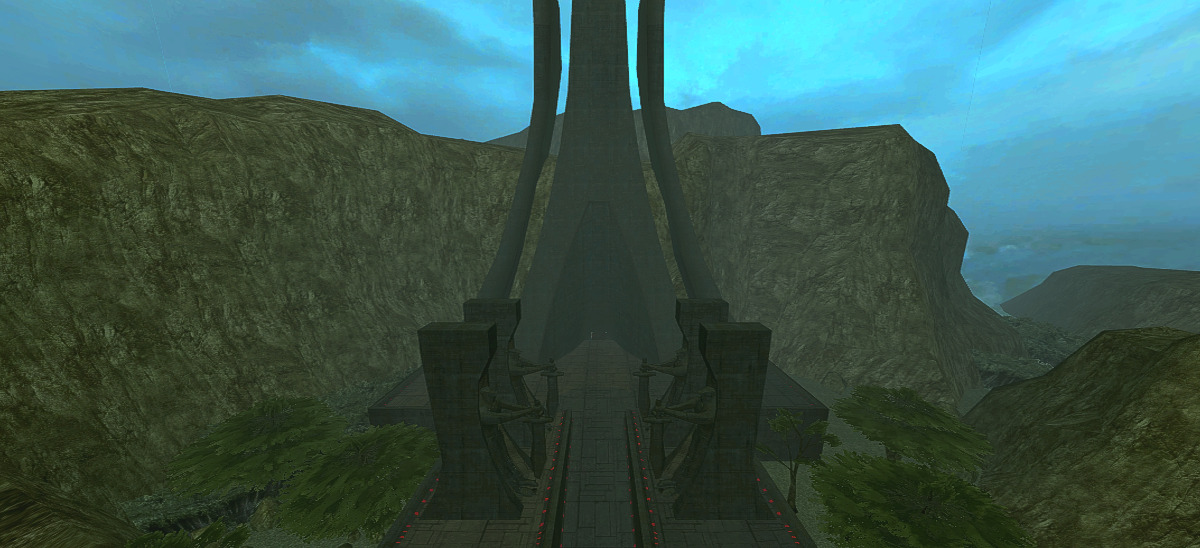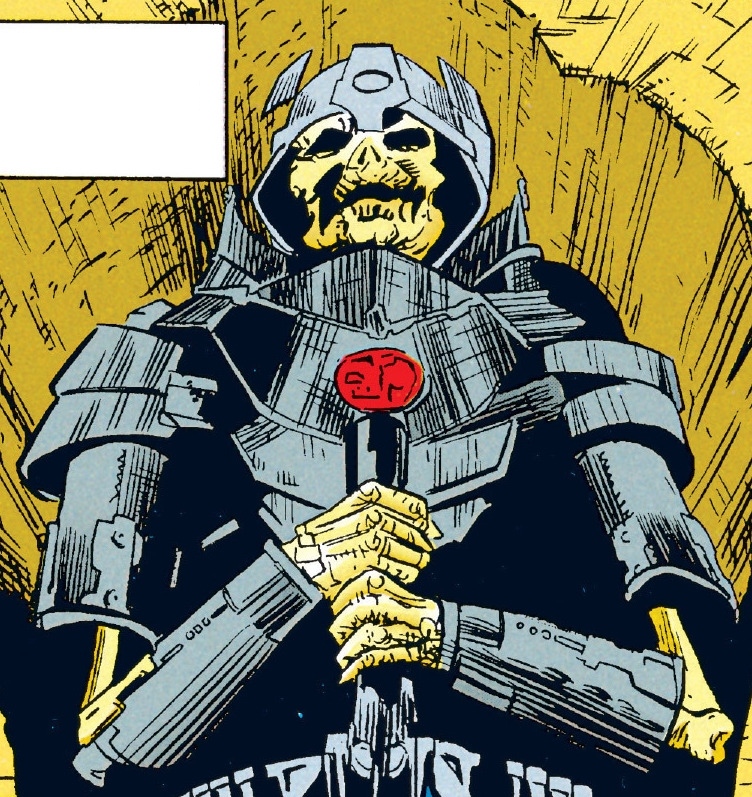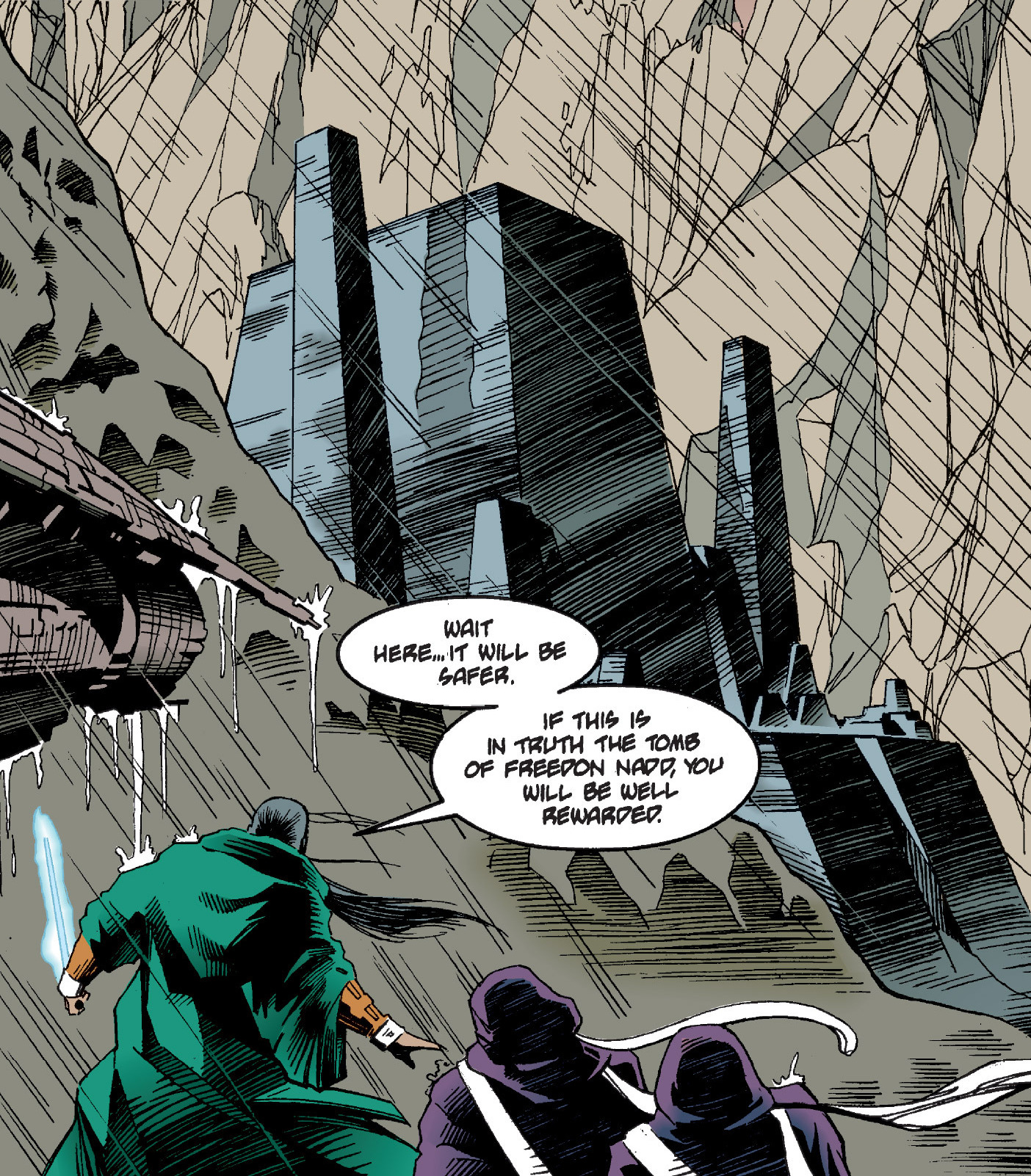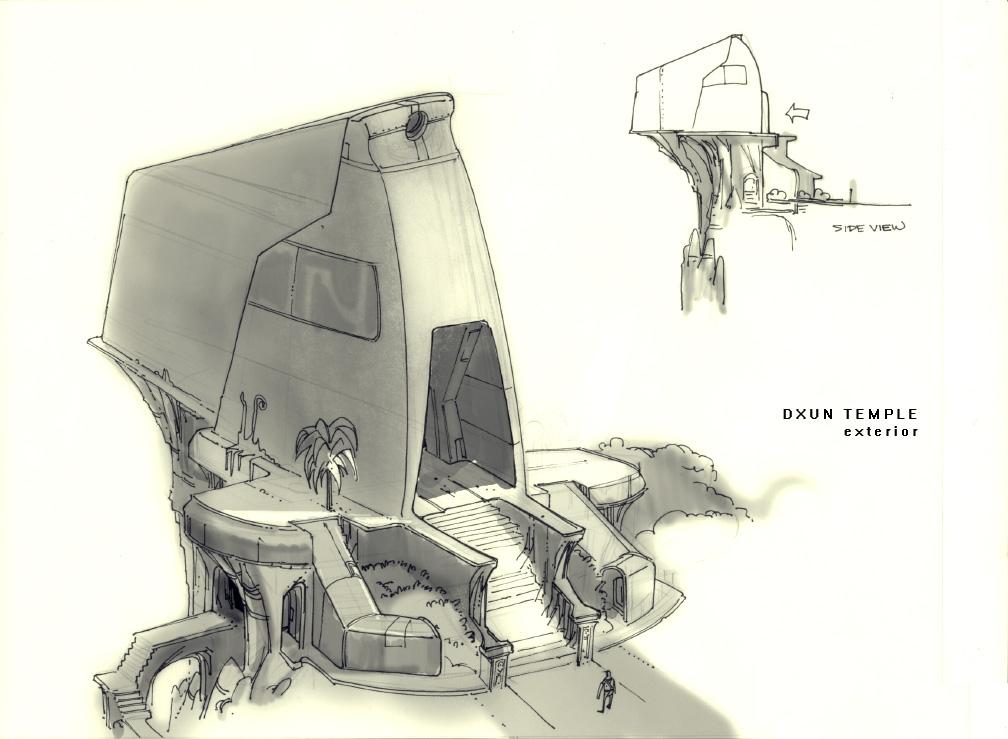The Tomb of Freedon Nadd was a mausoleum that served as the final resting place for the physical remains of King Ommin and Queen Amanoa of Onderon, as well as their Sith ancestor, the Dark Lord Freedon Nadd. The original tomb, which consisted of nothing more than Nadd's sarcophagus within a hollowed section beneath the royal palace of Iziz, was cleansed of its potency with the end of the planet Onderon's Beast Wars. After the final defeat of Freedon Nadd's worshippers in 3998 BBY, Jedi Master Arca Jeth ordered the construction of a new tomb on the nearby jungle moon Dxun to contain Nadd's remains and their residual dark side energies. Entombed alongside the Dark Lord were Queen Amanoa and King Ommin, with whom died the last vestiges of Nadd's Sith dynasty.
Freedon Nadd's tomb was visited a year later by the Dark Jedi Exar Kun, who penetrated its nearly-indestructible exterior in search of forbidden secrets. The tomb remained unvisited for nearly the next forty years, when Sith forces loyal to the Dark Lord Darth Nihilus were defeated by companions of Meetra Surik. Three millennia later, Nadd's tomb was found and explored by the Sith'ari Darth Bane, wherein he discovered Nadd's holocron, and the plight of the orbalisk Force-parasite.

The Tomb of Freedon Nadd on Dxun.
The original tomb of the ancient Jedi apprentice-turned-Dark Lord of the Sith Freedon Nadd consisted of nothing more than a hidden cave beneath the royal palace of Iziz, the capital city of the planet Onderon. A secret, winding, tunnel known only to Iziz's Queen Amanoa was the single means by which the tomb was reached. Damp, dark, and cold, the path led to a large, heavy stone slab that barred further entry, behind which was a cave with the capacity to support only a handful of beings at any given time. Because the enormous sarcophagus of Freedon Nadd was an object of potent dark side power itself, the tomb in which it was kept became a reservoir of malevolent Force energy, which in turn suffused Iziz, then the planet, and eventually the entirety of the Onderon system with the power of Sith magic. The tomb of Freedon Nadd beneath the Iziz royal palace therefore served as the seat of Queen Amanoa's power, whereto she withdrew in times of great peril to summon the spirit and power of Freedon Nadd himself. Despite the secrecy that shrouded its location, however, rumors of the existence of Nadd's tomb were prevalent among the citizens of Onderon.
Following the end of the Naddist insurrection in 3998 BBY, the Dark Lord's tomb was relocated to an obsidian, tiered, trapezoidal edifice fortress of nigh-impenetrable, mirror-surfaced Mandalorian iron, on the nearby moon of Dxun. A single road led to a circular bastion replete with spiked and cannon-equipped emplacements to repel treasure-seekers and plunderers alike, all surrounded by a deep trench. The avenue branched off in either direction once passed the fortification's threshold, but the primary thoroughfare continued just past enormous braziers with fires blazing at the foot of the tomb, and ended at a long staircase situated between ramparts on either side that led to the temple's entrance. At the summit of the stairs was a long avenue lined with four statues, two on either side, of sword-armed beings whose weapons were extended outward but pointed down. A pair of monoliths the height of the tomb's main structure protruded upward on both sides of the building, with another set of smaller plinths flanking the entrance. The dark side power that emanated from the tomb warped the structure of the building over time; merely two years after its construction, iron outcroppings had jutted upward near the entrance, and subsequent centuries of malevolent infusion dimpled the walls of the tomb so that it eventually became more pyramidal, yet asymmetrical, in appearance. Even the monoliths had been drawn in close to the building, their prominent and upright erection reduced to curved parallels of the temple's shape.
The interior of Freedon Nadd's tomb opened to a small, low-ceiling antechamber, with passages that branched off in three separate directions. In the main chamber, amongst a menagerie of Sith treasure and artifacts, were the sarcophagi of Onderon's dark side elite: King Ommin and Queen Amanoa, and their Sith Master, Freedon Nadd. The path to the left of the antechamber led down a hall lined with various chambers, and eventually split into several winding routes. At the tunnel's end was the heart of the tomb, where a small chamber was barred by a tight-fitting, meter-wide slab of ebony stone. Behind the black door was a circular room about five meters in height and diameter, with a stone pedestal in the exact center, on top of which sat the holocron of Freedon Nadd. The device was protected by an entire colony of orbalisk parasites that covered the expanse of the chamber. Decades after the tomb's consecration, Freedon Nadd's husk was moved to an adjacent room where a shrine had been dedicated to the performance of rituals in his name. A single torch-bearing statue was situated on either side of a raised altar that also housed the new sarcophagus. Three additional torches were set directly in front, behind which was a long rectangular pool of water. Atop the mausoleum was a massive platformed statue of Freedon Nadd, and within were the Dark Lord's remains, and his personal lightsaber.

Freedon Nadd's remains were kept in the bowels of the Iziz royal palace.
In 4000 BBY, when the forces of Iziz went to war against the combined might of the Jedi and Modon Kira's Beast Riders, Amanoa quietly sneaked away under her palace to Nadd's tomb, and drew fully on the power of the dark side focused in his remains. Chanting his name, Amanoa invoked Nadd's spirit and used its power to cause panic and terror amongst the armies of Beast Riders. However, when confronted by the light of Jedi Master Arca Jeth, the shadow of Nadd's spirit was driven from the tomb. Amanoa died, the shadow having been driven from her as well.
To purge the dark side from Onderon permanently, Jeth planned to relocate the sarcophagus along with Amanoa's coffin to Onderon's nearby moon, Dxun. He surmised that the moon's natural fauna would be more than sufficient in deterring any would-be grave robbers. But before the sarcophagi could be moved, they were stolen by the Dark Jedi Warb Null and his army of Naddists, who surprised the Jedi from below with a massive tunnel-boring war machine and confiscated the coffins, retreating with them into the tunnels underground. Master Jeth and his Jedi apprentice Ulic Qel-Droma, led by Queen Galia, followed the Naddists underground where they discovered Warb Null and King Ommin, who was alive and, much to their horror, in league with Freedon Nadd's spirit. Though Ommin was able to subdue and capture Jeth with his Force lightning, the Jedi Master was eventually rescued by a team of Jedi Knights. Ommin was killed, and Nadd's spirit was finally removed from Onderon. Jeth took the sarcophagi of King Ommin, Queen Amanoa, and Freedon Nadd, and finally moved them to Dxun. Building an actual mausoleum of Mandalorian iron, Jeth sealed the tomb and placed it in a remote area of Dxun, to be hopefully left undisturbed.

Freedon Nadd's tomb is visited by Exar Kun.
Beings who were themselves steeped in the dark side felt compelled to seek out the source of Dxun's powerful miasma that was the tomb of Freedon Nadd. In 3997 BBY, it was discovered by the Jedi Exar Kun who managed to break in after finally penetrating the wall with his lightsaber. Upon entering he was confronted by Freedon Nadd's ghost, who directed him to the scrolls hidden under his bones. The scrolls pointed Kun to Korriban, where he would be reunited with Nadd, apprenticed to him and acquire tremendous Sith powers. After the second death of Freedon Nadd, his spirit was banished to Chaos, and the tomb would remain undisturbed for little more than thirty years.
In 3951 BBY, the tomb was critical to the outcome of the Second Battle of Onderon. Sith forces under the Sith Lord Darth Nihilus and a Sith Master used Freedon Nadd's tomb as a base to support the Onderonian General Vaklu and his forces, who wished to overthrow Queen Talia. Transmissions from the Sith were tracked by the Mandalorians under the Mandalorian Kelborn. The current Mandalorian leader, Mandalore the Preserver, was journeying with the Jedi Knight Meetra Surik, known as the Jedi Exile in a quest to reunite the scattered Mandalorian clans. When Surik and her companions met with Kelborn, a companion of Surik's, Jedi Master Kreia, recognized that the Sith were on Dxun, and counseled action against the Sith. Before Surik headed to Onderon to assist the Royalists loyal to Queen Talia, she charged three of her companions with stopping these Sith. Surik's companions successfully prevented the Sith Masters in the tomb from performing a dark side ritual.
About three thousand years later, the Sith Lord Darth Bane traveled to Freedon Nadd's tomb in search of potential secrets for creating holocrons. When he entered the tomb, Bane was displeased to learn that someone had been there before him, though he did not know how long ago. He pressed on despite his disillusioned suspicion that his trip had been for nothing, until he happened upon an undisturbed chamber, sealed with thick slab of Mandalorian iron. At first Bane was not able to enter the room, but then he used the dark side to throw the door across the room. Then, he saw that the room held its own holocron. Bane soon learned that the holocron was not the only thing housed in that room. The secret chamber was infested with orbalisk, tiny crustacean-like creatures that feed on the power of the dark side. When Bane tried to remove the holocron, two of the orbalisks attached themselves to him, one to his chest and the other on his back. Lord Bane remained in the tomb for four days while he delved into its crystal lattices, after which he left the tomb and Dxun with the holocron as well.

Concept art of Freedon Nadd's Tomb.
The tomb of Freedon Nadd was first introduced in the Dark Lords of the Sith story arc of the Tales of the Jedi series of comic books, published by Dark Horse Comics. The burial site was later featured in the 2005 Xbox and PC video game Star Wars: Knights of the Old Republic II: The Sith Lords, developed by Obsidian Entertainment. Nadd's tomb serves as a key plot element within the game's storyline. Nadd's tomb was mentioned in Freedon Nadd's entry in The Complete Star Wars Encyclopedia.
If the leader of the expedition has training in the ways of the Force, he or she has a chance to acquire new powers in the tomb, drawing upon a pair of dark side energy nexuses that could be found in the tomb. The first nexus offers the power of Slow, while the second can grant the power of Affliction, provided neither power has yet been chosen by that character during level-up. Alternately, if the character chooses to control their emotions and successfully resists, a temporary bonus to strength and constitution stats can be earned. Surik's companion in charge of the mission to Freedon Nadd's tomb is recognized as a Force-sensitive by the Sith Master and his fellow Masters. The Sith Master offered the leader a chance to embrace the dark side and the power that the Sith were harnessing to control the beasts on Onderon and Dxun.
- "Straight from the Horse's Mouth: A Guide to the Star Wars: Tales of the Jedi Universe, Part 1" — Star Wars Insider 26
- "Straight from the Horse's Mouth: A Guide to the Star Wars: Tales of the Jedi Universe, Part 2" — Star Wars Insider 27
- The Jedi Academy Sourcebook
- "ComicScan: Taken by Force" — Star Wars Galaxy Magazine 8
- Tales of the Jedi Companion
- Star Wars Encyclopedia
- The Essential Chronology
- "The Sith Compendium" — Star Wars Gamer 5
- The Dark Side Sourcebook
- The Official Star Wars Fact File1
- The Official Star Wars Fact File90
- The Official Star Wars Fact File113
- Star Wars: Knights of the Old Republic II: The Sith Lords: Prima Official Game Guide
- Jedi vs. Sith: The Essential Guide to the Force
- The Complete Star Wars Encyclopedia
- Jedi Academy Training Manual
- The Essential Atlas
- Star Wars: Edge of the Empire Core Rulebook
- Star Wars: Age of Rebellion Core Rulebook